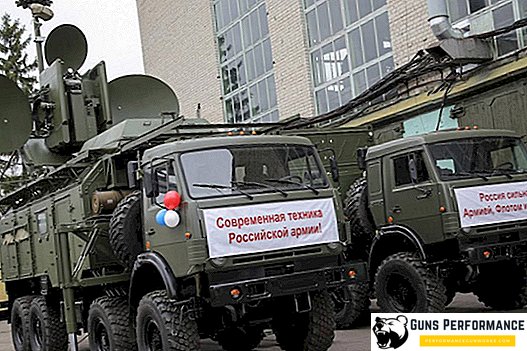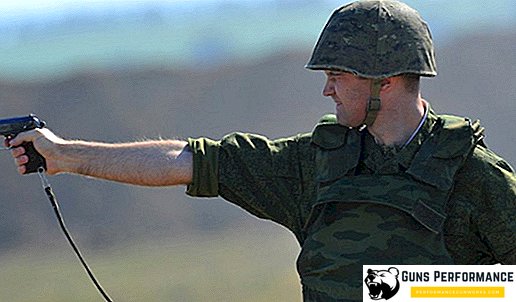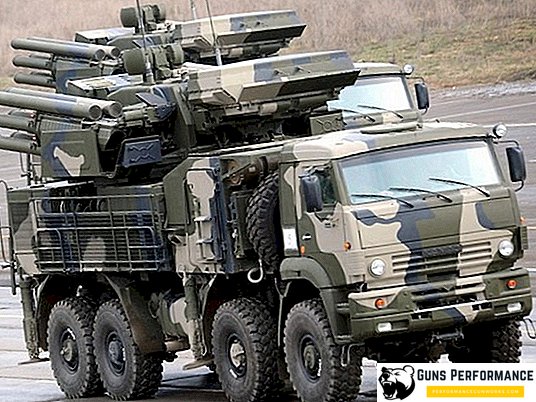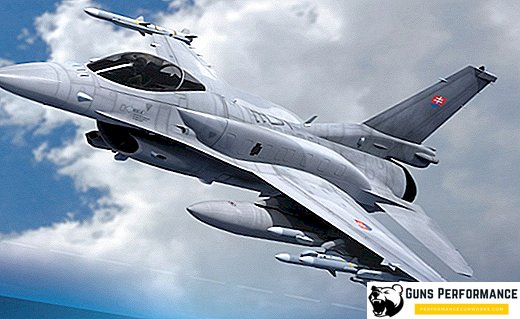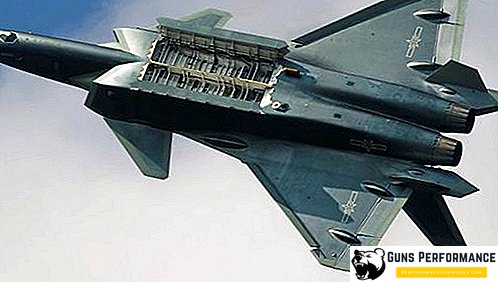Traditional Ukrainian men's suits have a considerable resemblance to other East Slavic clothes. They are based on shirts made from hemp or linen fabrics, as well as wool or cloth pants. Shirts worn on the body, often served as outerwear. Distinctive features of men's Ukrainian shirts is the presence of a front incision (ridge), decorated with embroidery.
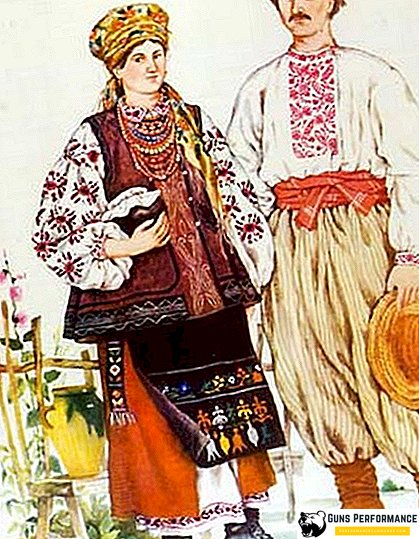
Construction collars shirts can be standing, with turn-down collars or without collars. Shirts in such cases are assembled in assemblies, sheathed with braid or narrow strips of fabric. Thus, low stand-up collars are sewn, which are sewn to the gates from the bottom of the shirt. There were Ukrainian men's clothing and wide turn-down collars.
Shirts are fastened or fastened at the gate with buttons or ribbons. Men wear shirts tucked into their pants. In the tailoring of the shirts, all the Eastern Slavic peoples made inserts in the armpits with triangular quadrilateral pieces of matter. The shoulders of Ukrainian shirts were decorated with shoulder straps or embroidered inserts - “settings”.
Ukrainian folk costume
Pants were attached to the body with the help of laces or belts that were worn with buckles. Cossack pants were very wide. Rectangular pieces of fabric with rhomboid sewn together were sewn between the trouser-legs, they were so wide that it turned out to be similar to the shape of the bag. The material for the pants served as canvas or cloth.
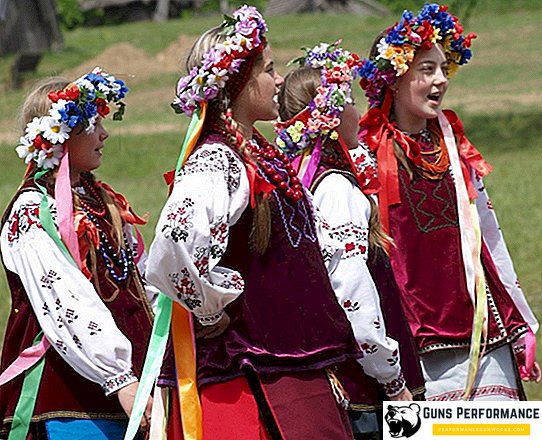
Ukrainian women’s folk costume had many local variations. The features of ethnography in the historical, cultural regions of Ukraine were reflected in clothes, cut, some elements of traditional clothes, ways of wearing them, colors, décor, and jewelry.
Distribution of traditional outfits by regions of Ukraine
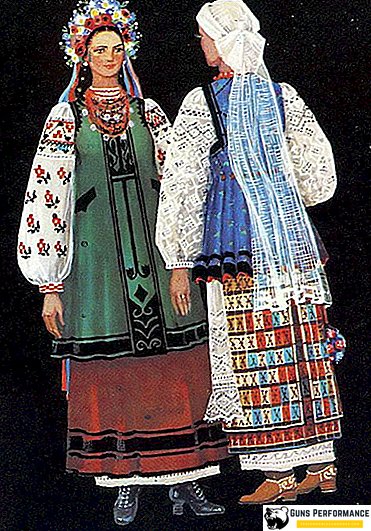
The main differences of traditional dresses, which are represented in Ukraine, can be considered:
- The archaic nature of the elements of clothing was preserved the most in the areas of Polesye;
- Classic Ukrainian clothes could be found in the Middle Dnieper;
- In the south, the influence of traditional costumes of different nations;
- Ethnocultural relations of Ukrainians and Moldovans were noted in Podolia;
- In the northwest, there was a connection with Poland;
- Special and colorful clothes wore Ukrainian highlanders.
Be that as it may, ethnographers attribute the traditional clothes of Ukrainians, as fully developed, to the 16th-18th centuries.
The most common traditional Ukrainian costumes were in the Middle Dnieper region, as well as a little in Polesie, Slobozhanshchyna and Podolia. Outerwear men and women were similar in cut. The basis of Ukrainian women's suits were shirts - kosuli, shirts. They were longer than men's shirts and included two parts, with the bottom sewn from coarser fabrics.
The mountaineers, the strikers, and the lemks also had shirts of two parts, each of which was worn separately. There were also solid shirts, in fact, they were for women as elegant and festive. Proceeding from the cut, the shirts were tune-like, polikovye, as well as on a yoke.
Shirts could be sewn with gates, as well as without them. These types of shirts were considered more ancient. Their winches were usually assembled into small assemblies, and sometimes they were trimmed on top. Shirts with collars were called Polish. The so-called conditional line between the two types of shirts was carried out on the territory of Ukraine. So, in the eastern regions they were without collars, and in the western - with collars, more often - turndown.
A distinctive feature of Ukrainian women's shirts was the decoration of the hem, the border of the shirts with embroidery, seen under the outerwear. In addition, there were decorations on the sleeves of shirts, especially where the sleeve was connected to the shoulder. The wide sleeves of the graduation shirts were in the form of cuffs on the wrists.
Features of the belt
According to ancient customs, East Slavic girls under fifteen years of age or before the wedding were to have belted shirts. The ritual of donning the lap clothes (having rendered it) was associated with marriage, after which the girls became women. Ponevy were all-Slavic elements in traditional clothes, which covered the body from behind and fixed in the waist area.
Ukrainians had three types of such clothes:
- Everyday without drawings - spare wheels;
- Durga;
- Holiday outfits with large cells - plakhta.
Dergs are three stitched long sheets that form a three-meter-wide strip of fabric and up to three-fourths in length. They covered the corps of women from behind and tied up with a belt. Since the dergie was considered everyday clothing, they were sewn from black or unpainted fabrics, without ornaments.
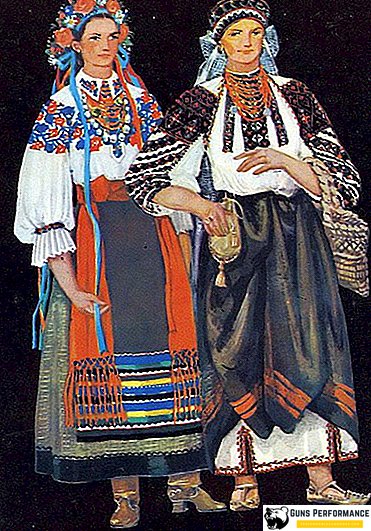
Stocks differed from the strands in that their upper corners had ribbons tied at the waist. Two spare wheels were usually worn, often in different colors. One body was covered from behind, the other, worn on the front, was used as an apron. Reserve made from high-quality and thin woolen and monophonic fabrics. They were blue, green, and also red.
Plakhty as festive clothing were made of fabrics with a checkered ornament. They were embroidered by hand. Known woolen or silk coat. In the early periods, plakhta were sewn from gold and silver types of brocade.
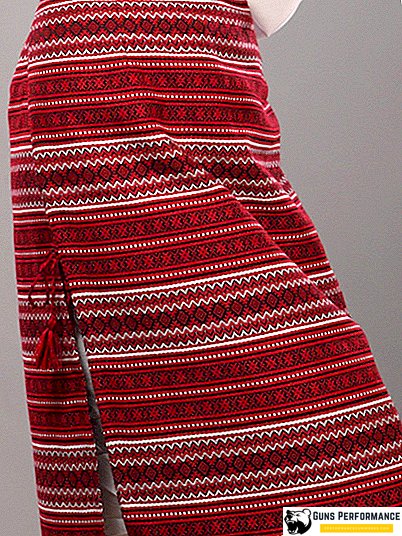
Further evolving skirts are considered. So in the Polesie region such woolen skirts with striped ornaments - andaraks, were widespread. In addition to women's costumes were chest decorations. The material for them could serve as gems, glass, beads, as well as coins such as "monist" or "dukachey."
Ukrainian outerwear
In the outerwear of the Ukrainians, there was a variety associated with the cut and names.
The history of fashion identifies four types of such clothing:
- Straight-backed type cloaks, shirts or robes. The cloaks were chugi, chugi, chugani, which were common among the Westernizers. Chugi barely pounced on the shoulders and not put on the sleeves. The sleeves themselves were sometimes sewn down. Thus, they were used as pockets or bags;
- Forms of cloaks of mantas or google in Hutsuls resembled large bags, open from one long side. The hood was the bottom of the bag, which was attached to the shoulders with the help of special laces. At the beginning of the 20th century, manti served only as ceremonial clothing for brides at a wedding;
- For coats, belonged Cobenics, Kirei, Siryaks. They wore retinues with cobenics. Stoovbovye suites wore on top of fur coats, and were sewn from cloth mainly of gray colors. The hoods sewn on them to vidlog, kobki, kaptury, beard, shanki, virgin had the form of bags with a rounded bottom and holes for the eyes;
- Widespread cut of outerwear Ukrainians were wedge-shaped silhouettes. So, the wedges sewn behind behind from the sides below the waist. The sharp ends of the wedges reached the waist, and the bases were in the hem area. The same patterns were made for the retinues, Siraki, kuzinki and gunas;
- Outerwear cut to the waist. In this case, the lower parts were assembled in large folds, or in small assemblies, after which they were sewn to the upper parts. This was the way of the retinue, the leather (fur coats), the kiersetts - women's jackets without sleeves.
In the latter case, the assembly was done across the waist. These types of clothing were Chemer, Checkers, Chamarks.
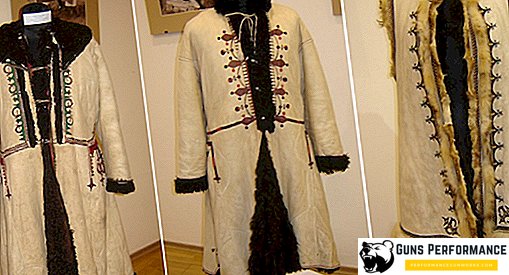
One of the mandatory attributes in the clothes of the Ukrainian people was considered a belt. According to East Slavic mythology, the belts acted as amulets, he defended the body. The waist was wrapped with three-, four-meter belts several times, and the ends, ending with brushes, were released below the knees. At one time, Persian silk belts were popular, and brides girded with embroidered towels - towels.
Headgear Ukrainians
Hats Ukrainian men were very diverse. This was reflected in the forms, materials and names. Cones, cylinders, and also a semicircle were popular forms. There were fur, wool and hats made of cloth. For example, there were high wing caps (Kuchmas), winter caps with elongated headphones (treuhi, malachai), felt and straw hats (flews). At the end of the 19th century, widespread caps with caps began to be worn.
There was also a wide variety of women's headdresses, including their intended use. One of the most popular hats used by married women is a square scarf. It originates from the head covers - long canvases, which were tied behind, releasing the edges on the back. Similar headdresses remained in the west of Ukraine. Headgear such as kibalok, khomevok, komley in their simplest forms had the appearance of hoops or arcs facing backwards. Women were spinning their hair on them. Cybalki served as a frame for the top headgear.

The simplified versions of the headwear of Ukrainian women were soft light caps (trimming, caps, caps), which were tied with laces, passed through the binder. Caps were sewn from pieces of thin fabric of different colors with a transverse undercut on the forehead. The undercuts were made in such a way that something like small assemblies was formed above the forehead, while the material on the forehead remained smooth. Scars were laid on the back of the head, through which the laces were passed. Festive caps were sewn from a brocade of gold or silver flowers.
World-famous at all times maiden wreaths of artificial and natural flowers with ribbons, were very popular in Ukraine. These girls' headwears did not require closure of the head and braid. By the way, braids were the main hairstyles of Ukrainian girls. The girls wove their hair in one or two braids, wrapped around their heads and tied with colorful bandages decorated with beads.
Shoes of the Ukrainian people
The shoes of the Ukrainian people for both sexes were made of leather. At first they did not sew it, but folded it, tried to wrinkle it, and then tied it to my legs with long ropes. Hence their name - wrinkles, wrinkles, postols, walkers. There were no heels in leather shoes with high tops. Sometimes heels were replaced with small iron shoes on the heels.
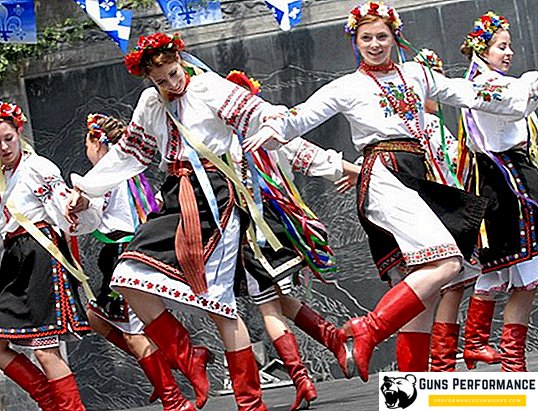
From the middle of the XIX century, special boots, the so-called inversion shoes, prevailed. Soles were sewn to the boots from the inside, and the boots were completely wetted with water and turned out.
Symbols of Ukrainian folk costumes
In any ritual symbolism of costumes, the spiritual traditions of the people were reflected, as well as their world view and ritual norms. These ritual symbols were some items of clothing. These could be handkerchiefs or towels in the matchmaking process, white or black handkerchiefs, etc. They were assigned the role of advocates of people from dark forces and a way to attract well-being, health and love.
Special magic powers, as was commonly believed, possessed objects, personally made to certain rites. For example, girls had to sew embroidered shirts to their brides. Indispensable gifts, for example, boots made by the son-in-law for mother-in-law, had a symbolic significance.
Ritual functions, except for the style of clothing, manifested in some specificity. For example, in some rituals, clothing was worn inside out, which in everyday life was considered as a bad omen. In some rituals, dressing in the clothes of opposite sexes occurred.

Ritual symbols can often be found in the colors of clothes. Red colors dominated wedding dresses from old times. While the funeral clothes were distinguished by black colors, which were one of the symbols of sadness in most areas of the end of the XIX, beginning - of the XX centuries, replacing the white, and sometimes blue.
Traditional embroidery of the Ukrainian people
One of the objects of pride in folk art is Ukrainian embroidery. She was often used both in folk costumes and in everyday life. Embroidery in Ukrainian outfits differed in wealth and diversity. She decorated men's and women's shirts, outerwear, and hats.
Ornaments, compositional motifs, colors, traditions were inherited. Geometrical figures such as rhombuses, rosettes, stars, and also plants prevailed in the ornaments. There were many technologies for embroidery along with their varieties. The oldest species in folk embroidery were also quite a few. One of the variations in such techniques is quite popular in the Ukrainian embroidery by satin stitch.
The color scale of embroidery of the Ukrainian shirts belonged to one-color, two-color, and also to polychrome. The first such shirts were characteristic of the Poles, as well as the population of the Chernihiv and Poltava regions. Two-color mainly used by residents of the Kiev region and in the valley. The Ukrainians used the polychrome in the Western Podolia region, as well as in the Carpathians.
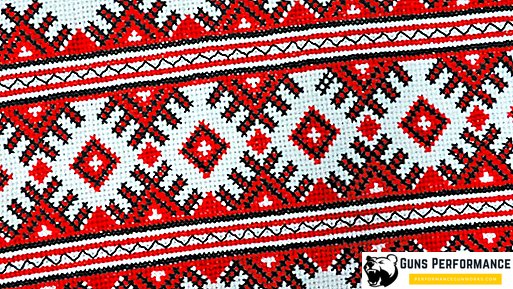
In the embroidery of the northern regions of Ukraine, the predominance of red was observed. In the central regions of Ukraine, besides red, black colors could be found. The southern regions added yellow to these ubiquitous colors. In the embroidery of Podillya, red-black combinations were often encountered. In the regions that bordered Bessarabia and Bukovina, one could encounter embroidery enriched with beads with metal decorations, which brought it closer to Moldovan and South Slavic ones.
Ukrainian art weaving was engaged in a wide development of plant ornamentation. And the most favorite motifs were fabrics, decorated with patterns, which depicted branched flowers or trees. Such motifs were characteristic both in the towels of homespun white material, and in carpet weaving, which was widespread in many regions of Ukraine, but most of all in the central and eastern regions.
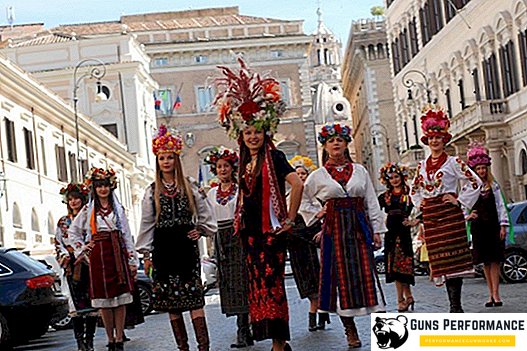
In the late 19th and early 20th centuries, the Ukrainian people preferred to switch to urban clothing. As a result of the "reclamation" and the general transition to "civilized" costumes, many features of national traditional dresses were lost.


